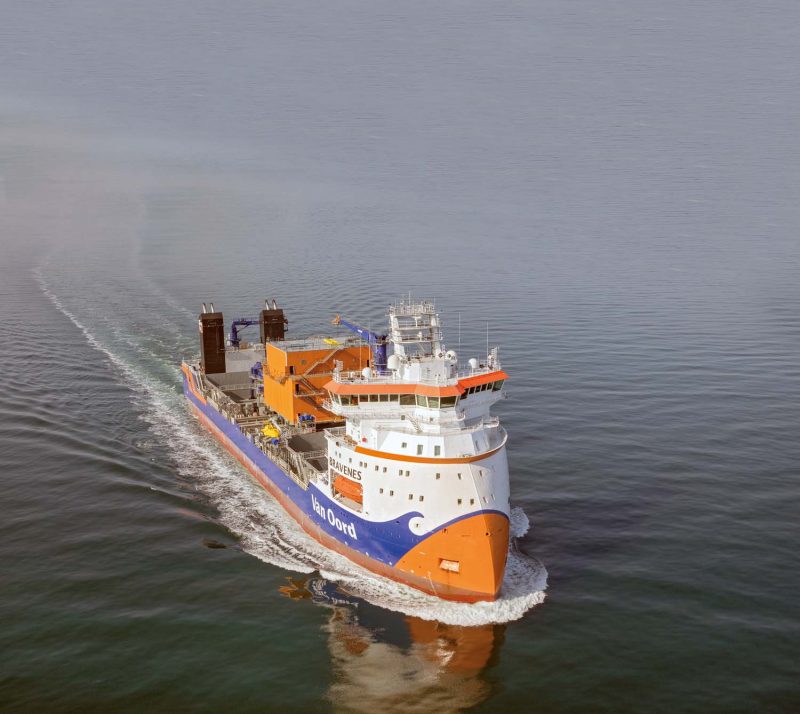
As has been demonstrated with previous Newbuild features, the modern-day scene of Marine Engineering has spawned a myriad of specialist vessels. Likewise, companies dedicated to marine engineering activities such as dredging have evolved and expanded with the changing needs of the industry to also specialise in other forms of subsea operation. One such business is the Dutch company of Van Oord, which can trace its roots back to 1868 when it was founded by Govert van Oord. The origins of Dutch marine engineering lie in the Netherlands’ unique location on the North Sea and its battle against the water. The history of Van Oord is entwined with the country’s biggest marine engineering works, including the Nieuwe Waterweg Canal, the Delta Works, and the Port of Rotterdam Maasvlakte II expansion. These were projects that fuelled economic growth and kept the population safe from flooding. The company has grown into an international marine contractor specialising in dredging, oil and gas infrastructure and offshore wind services. A succession of acquisitions and mergers has helped with this growth. By 2010 activities in dredging, offshore and wind energy dictated the need for an increase in custom-built vessels such as the 19,848gt/2013 built offshore installation vessel Aeolus, the 6,000gt/2015 built cable-laying vessel Nexus and the 9,547gt/2013 built Cutter Suction Dredger Artemis. Van Oord celebrated its 150th Anniversary in 2018 via a two-day event at the company’s home town of Werkendam. This event also featured the naming ceremony on 14th April of the new 768gt/68m long and 11m beam crane/hopper vessel Werkendam, Van Oord’s first LNG powered vessel. The naming ceremony was carried out by Pia Van Oord, the wife of Govert van Oord, who is the grandson of company founder Govert van Oord. The celebrations also included the unveiling on 14th April of a bronze statue of a local worker (“Griendwerker,” created by artist Jaap Hartman) on the Sasdijk dyke in Werkendam. Van Oord’s turnover in 2017 was €1.5 billion with a profit of €78 million. The fleet at that time included 22 Trailing Suction Hopper Dredgers, 11 Cutter Suction Dredgers, 12 Water Injection Dredgers, 2 Offshore Installation Vessels and 3 Flexible Fall Pipe Vessels.
A Subsea First
A fourth Flexible Fall Pipe Vessel joined the fleet in the form of the Bravenes (pronounced Brave-ness) in 2017, complimenting the existing trio of the 19,950gt/2011 built Stornes, the 18,226gt/2001 built Nordnes and the 7,857gt/1985 built Tertnes with 27,000t, 26,000t and 11,000t capacities respectively.
The names end in “nes” (Norwegian for cape) as this naming policy was inherited from the Norwegian company Jebsens, a past strategic partner of Van Oord, with both companies having successfully operated fall pipe vessels for 25 years. It is worth noting here that Van Oord holds the world record for the precise placement of rock in the deepest water. The rock was installed at a depth of 1,277m as part of the development of the Asta Hansteen gas field and the Polared pipeline for Statoil. The form of the Bravenes is very different to her fleet mates as she was born out of the Ulstein E169 design, complete with the distinctive and innovative X-Bow, the first vessel of her type in the world with this bow form. Designed by Ulstein Design & Solutions B.V, the vessel was originally ordered in 2014, the steel cutting followed in September 2015 and construction began in 2016 as Yard No. ZJ2031 at the Zhejiang Shipbuilding Co. Shipyard in Ningbo, China, part of the Sinopacific Shipbuilding Group.
Established in 2003, the shipyard encountered a troubled period in early 2016 when it was placed under bankruptcy restructuring. The embattled company then adopted a series of austerity measures to streamline the organisation, improve the management system and secure resources to resume yard operations. The facility had specialised in OSVs but when the offshore sector was hit by the collapse of oil prices and subsequent glut of OSVs globally, many of the OSV orientated shipyards struggled to survive or, worse still, ceased, when orders were cancelled or deferred. The Bravenes was launched on 14th December 2016 with a long fitting out period following prior to delivery on 18th December 2017. The ship then sailed to Xiamen for the installation of the Fall Pipe Deployment system before final outfitting/commissioning took place at Damen’s Shiprepair facility in Rotterdam. Whilst the general description for a ship such as the Bravenes is Flexible Fall Pipe Vessel, she is in fact known as a Subsea Rock Installation Vessel (SRI). The need for a steady platform whilst undertaking subsea work makes the X-Bow hull form an obvious choice as the tapered fore ship profile results in a wave piercing effect at small wave heights and reduces pitching and bow impact loads in heavier seas. When comparing fore ship volumes with more conventional, bulbous bow shapes, the X-Bow has more displacement volume starting from the waterline. Instead of simply rising on the waves and then dropping with tremendous force, the X-Bow is able to absorb the force more consistently across its surface, reducing slamming, noise and vibrations and therefore enabling the ship to remain more stable during poor weather conditions. This enhances comfort levels for crewmembers and increases the ability of the vessel to maintain operations in a variety of sea conditions. The X-Bow first appeared on the global shipping scene in 2006 when the 4,311gt AHTS Bourbon Orca was delivered, and there are now over 100 such ships operating around the world. Working in close cooperation with Van Oord, this is the first fully integrated design where Ulstein has been responsible for the development and integration of both the operational equipment and vessel design. SRI vessels stabilise and protect subsea pipelines, cables and other structures on the sea bed. Ulstein has also supplied the main Fall Pipe Deployment system and the majority of the ancillary systems of the rock installation tower. The overall length of the ship is 154.4m with a beam of 28m, a hull depth to the main deck of 13.3m, a maximum draught of 8m and a length between perpendiculars of 147.9m. The maximum deadweight is 14,000t and the gross tonnage is 21,133gt. The ship has capacity for a maximum of 60 crewmembers and technicians with the 6 decks of accommodation and facilities located in the forward superstructure.
A Tower of Strength
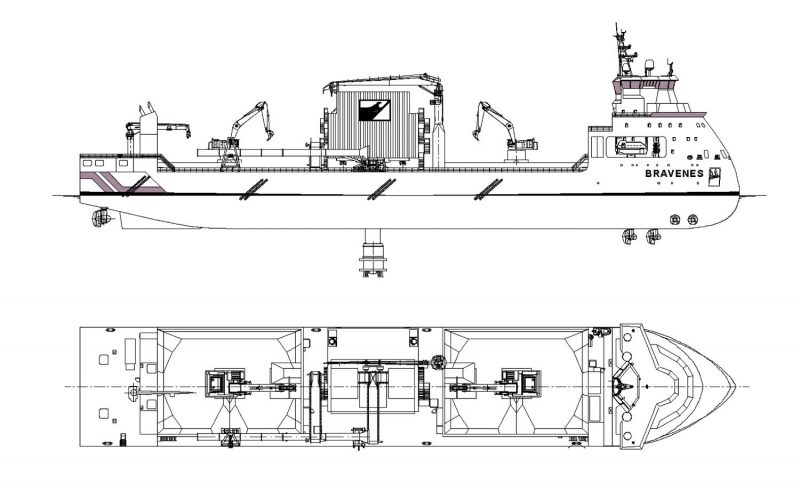

The heavy-duty requirements of the ship’s intended use reflect in the purposeful and robust external appearance of the Bravenes. The vessel can carry a maximum cargo of 15,500t of rocks in two 7,750t capacity holds situated at either end of the working deck and can load herself if required. The ship is of an innovative configuration in her class owing to the ability to install rocks in three different ways. The Bravenes can send rocks down a Fall Pipe inserted through a moonpool, through a Fall Pipe over the side or through a tremie pipe over the side. Thanks to the latter method, the vessel can perform subsea rock installation at close proximity to offshore platforms and equipment. Located amidships is the hi-tech and innovative Fall Pipe Tower (orange in colour), the centrepiece of the ship’s capabilities, with a deadweight in excess of 1,000t. Housed within the tower is a Remotely Operated Vehicle (ROV), which is deployed when a sliding hatch on which the ROV sits is moved clear to allow the ROV to descend through a 6.30m x 6.30m moonpool beneath in the ship’s hull. The ROV leads the 1.5m diameter fall pipe, which consists of a continuous string of interlinked bucket shaped sections, lowered by cables towards the ocean floor for deep water operations. The ROV is stabilised by two lateral arms that deploy when clear of the hull and is propelled by six 75kW propulsion units. It first scans the contours of the work area using equipment in the lateral arms and then the rocks are sent down through the pipe to the designated area. The subsea operating depth of this system is 1,000 metres and it can handle rocks from 60kg to 300kg in size. Up to 2,000 tonnes of rock per hour can be delivered from the ship. For working close to offshore installations, the Fall Pipe Tower slides hydraulically out over the ship’s side to allow the ROV and fall pipe to be deployed directly into the ocean for medium depth deployment of around 600m. The sliding manoeuvres are made possible by a skidding system that was designed and installed by a company called Hydrauvision. The arrangement consists of four skid shoes in combination with two skid boxes, hydraulic rams and a control system. The skid shoes form the connection between the ship and the Fall Pipe Tower. Wave action places very large forces on the skid shoes so they are very robust in their construction. Thanks to the skidding mechanism, the vessel can deposit dense rock layers close to the base of offshore platforms, or structures founded on monopiles. A third method of deploying rocks in shallow waters is via a 1.5m diameter tremie pipe located and stowed on the starboard side of the ship. This is hydraulically moved into position beneath the hopper feed at the Fall Pipe Tower and larger rocks up to 500kg can be placed at a depth of 40m via this method, angled from the vessel as required. This makes the tremie pipe method ideal for around difficult to reach structures. The Fall Pipe Tower is supplied with aggregate via a gravity hopper and conveyor belt system from both cargo holds. Each hopper is loaded by a 360 degree Hitachi excavator fitted with a grab and centrally located on a pedestal in each hold. Located on the port side, forward of the Fall Pipe Tower, is a hydraulic Liebherr deck crane with a height in excess of the tower, with a smaller crane located at the stern between the twin funnels.
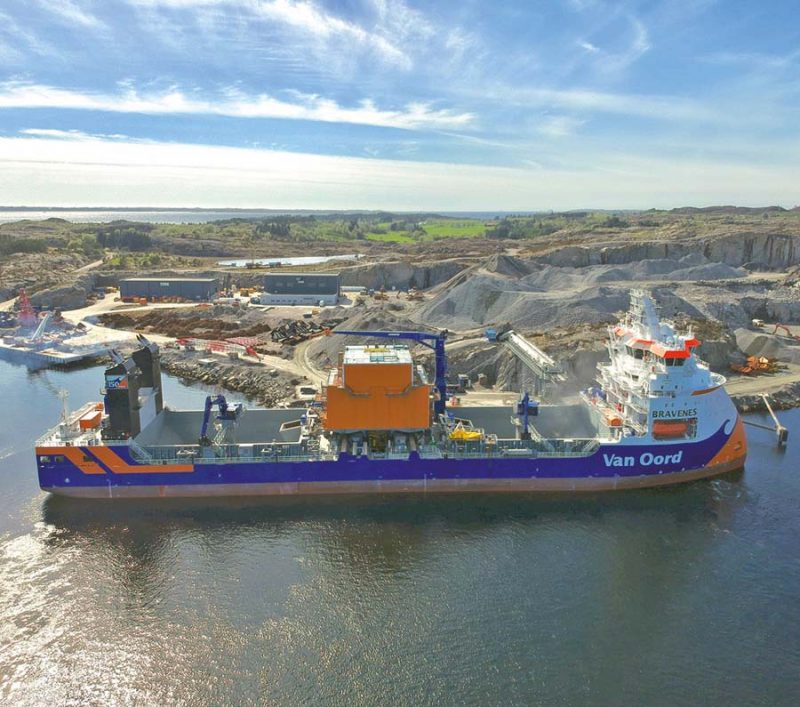
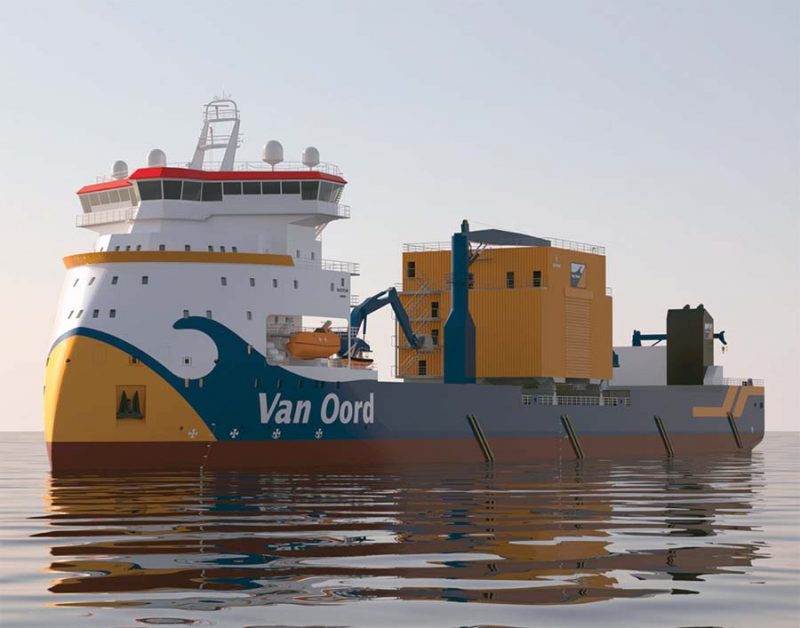
Rock Steady
To allow the Bravenes to perform her delivery of rocks on cables, pipelines and structures she is equipped with a DP-3 system (Dynamic Positioning). Two retractable 2,000kW Brunvoll AR100 azimuth thrusters located beneath the bow are deployed to work with the two 1,500kW FU90 transverse tunnel thrusters. The Bravenes is classified under Bureau Veritas Ice class 1A classification, including Polar Class 7, SPS Comf Noise 1, Comf Vib 1 cleanship, BWT, green passport, Sp60, grab-loading, special service/rock installation ship with unrestricted navigation.
The vessel is outfitted for year-round operations in adverse weather and high-sea conditions and has an endurance of up to 45 days between calls to port. The diesel-electric propulsion and onboard power is provided by two 3,840kW and two 2,880kW MAK main generator sets. An emergency generator of 900kW is also installed. The propulsion system comprises of two 3,100kW Schottel azimuthing thrusters that provide a loaded service speed of 12 knots. The Bravenes was of course delivered during Van Oord’s 150th Anniversary year so her naming ceremony on 21st May 2018 at Wilhelminakade in Rotterdam was an extra special occasion. The ceremony was undertaken by Yvon van Oord-Barbier, the wife of CEO Pieter van Oord. After the Christening celebrations the Bravenes executed scour protection and cable laying activities on various North Sea projects, such as Deutsche Bucht Offshore Wind Farm, East Anglia ONE Wind Farm, Norther Offshore Wind Farm and the Merkur Offshore Wind Farm. From mid-July she also carried out stabilisation operations for the Nord Stream 2 gas pipeline in the Baltic Sea. Besides the Werkendam and the Bravenes, a third newbuild was welcomed into the fleet during the 150th year in the form of the 22,454gt/2018 built trailing suction hopper dredger Vox Amalia. She arrived in Rotterdam under tow from Bilbao on 24th November and the year-long anniversary celebrations were brought to a close with a two-day event marking the christening of the dredger on 14th December. Her Majesty Queen Máxima performed the christening, also at the Wilhelminakade Cruise Terminal in Rotterdam, in the presence of Van Oord’s employees and guests.
Special thanks must go to Jeanine van der Zon, Communication Officer at Van Oord, for all the invaluable help with information, images and diagrams.
Technical Specifications
| Designer | Ulstein Design & Solutions B.V |
| Shipyard | Zhejiang Shipbuilding Co., China |
| Yard No. | ZJ2031 |
| Flag | The Netherlands |
| Port of Registry | Rotterdam |
| IMO | 9756200 |
| Ship Type | Subsea Rock Installation Vessel |
| Classifications | Clean Design Green passport ICE-1A |
| Class Notations | POLAR CLASS 7, COMF-NOISE 1, COMF-VIB 1, AUT-UMS (SS), SYS-NEQ-1 (SS) , GREEN PASSPORT, BWT, CLEANSHIP, ICE CLASS IA, GRABLOADING, IN WATER SURVEY, DYNAPOS AM/AT RS, COLD (H -20,E -20), OHS |
| Owner | SRI I B.V |
| Operator | Van Oord |
| Steel Cutting | September 2015 |
| Launched | 14th December 2016 |
| Delivery | 18th December 2017 & sailed to Xiamen for installation of the innovative Fall Pipe Deployment system. |
| Outfitting/commissioning | May 2018 at Damen Shiprepair Rotterdam |
| Naming Ceremony | 21st May 2018 |
| Gross Tonnage | 21,133 |
| Net Tonnage | 6,339 |
| Deadweight | 17,668 |
| Ice Class | 1A – PC7 |
| Length OA | 154.40m |
| Length P | 147.88m |
| Breadth | 28.00m |
| Hull Depth | 13.30m |
| Draught | 9.00m |
| Freeboard | 4,325mm |
| Total Power Output | 6,200kW |
| Diesel Generators | 2x MAK 4,689kVA/3,751kW/5,978hp2xMAK 3,332kVA/2,666kW/4,484hp |
| Emergency Generators | 1x 1,175kVA/940kW/1,351hp |
| Boiler | 2 CHF Alfa Laval 372m2/9.00 Bar |
| Propellers | 2x Schottel Azimuthing Thruster – Fixed 5m diameter @ 600rpm |
| Fixed Bow Thrusters | 2x 1,500kW FU90 |
| Retractable Bow Thrusters | 2x 2,000kW Brunvoll AR100 azimuth thrusters |
| Service Speed | 13 knots |
| Loaded Speed | 12 knots |
| Rock Capacity | 15,500t of rocks in two holds |
| Installation Depth | 40m-1,000m |
| Installation Capacity | Up to 2,000 tonnes per hour |
| Rock Handling Capacity | Up to 500kg in size |
| Bunker Capacities | |
| Heavy Fuel Oil | 1,500m3 |
| Marine Gas Oil | 500m3 |
| Fresh Water | 170m3 |
| Accommodation | 60 Crew/Technicians |

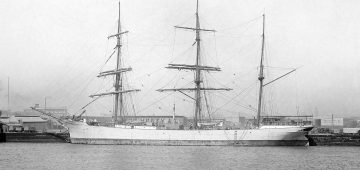



Comments
Sorry, comments are closed for this item